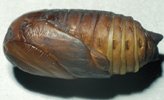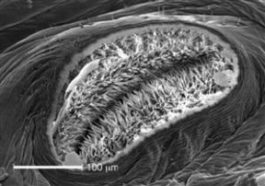Insects Take a Breather
Many types of insects appear to control how much oxygen they take in.
Share this:
- Share via email (Opens in new window) Email
- Click to share on Facebook (Opens in new window) Facebook
- Click to share on X (Opens in new window) X
- Click to share on Pinterest (Opens in new window) Pinterest
- Click to share on Reddit (Opens in new window) Reddit
- Share to Google Classroom (Opens in new window) Google Classroom
- Click to print (Opens in new window) Print
By Emily Sohn
Without oxygen, we’d be in big trouble. The gas, which makes up 21 percent of Earth’s atmosphere, keeps alive the cells that make up our bodies. But there’s such a thing as too much oxygen. Extra oxygen can damage tissues.
Insects need oxygen to live, too, and they can also get too much. Two researchers now propose that many ants, grasshoppers, moths, and other insects sometimes stop taking in oxygen for hours or even days at a time to avoid overdosing.
 |
|
Short slits at the right on this Atlas moth pupa open and close, perhaps to lessen damaging exposure to oxygen. |
| Stefan K. Hetz |
Insects breathe through little holes, or spiracles, that line their bodies. Oxygen enters through the spiracles, which lead to branching airways. Oxygen travels through these tubes to different parts of an insect’s body and diffuses into the blood and gets used by cells. The cells release carbon dioxide, which is carried back to the spiracles.
 |
|
Closeup of a beetle’s spiracle. The white bar represents 100 micrometers, or about the thickness of a human hair. |
| Nature |
Insect spiracles can open and close. Scientists had suggested that this opening and closing of air holes helps prevent water loss. Stefan K. Hetz of Humboldt University in Berlin and Timothy J. Bradley of the University of California, Irvine now propose that insects do it to keep their tissues from getting too much oxygen.
An insect’s airways can deliver oxygen 200,000 faster than the blood vessels of mammals typically can, and they whisk away carbon dioxide about 10,000 times faster. All of this oxygen exchange could harm an insect’s cells and tissue.
To investigate this idea, the researchers inserted measuring probes into spiracles of Atlas moth pupae. The pupa is the stage at which the caterpillar wraps itself in a covering and, hidden away, turns into a moth. The researchers then varied the concentration of oxygen in the environment.
 |
|
Researchers worked with the pupal stage (bottom) of an Atlas moth, the adults of which can grow to some 6 inches in width. |
| Stefan K. Hetz |
The results showed that oxygen concentrations inside the airways of the moths stayed the same, even when oxygen concentrations outside of their bodies varied quite a bit. This finding suggests that the insects close their spiracles to avoid getting too much oxygen, the researchers say.
Insects seem to be able to make sure they get just the right amount of a good thing.—E. Sohn
Going Deeper:
Milius, Susan. 2005. Bad breath: Insects zip holes to cut oxygen risks. Science News 167(Feb. 5):86. Available at http://www.sciencenews.org/articles/20050205/fob7.asp .
Information about how insects breathe is available at www.umass.edu/ent/BugNetMAP/mis_10.htm (University of Massachusetts) and science.howstuffworks.com/question555.htm (HowStuffWorks).
You can learn more about the atlas moth at cse-ferg41.unl.edu/pub/leps/index.html?page=atlas (University of Nebraska-Lincoln).







